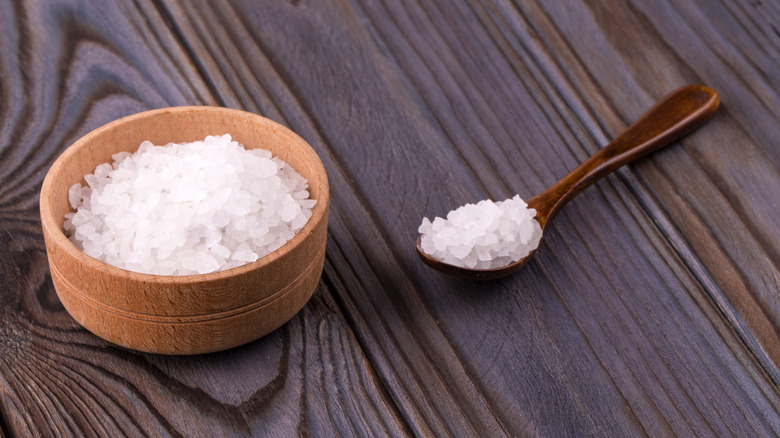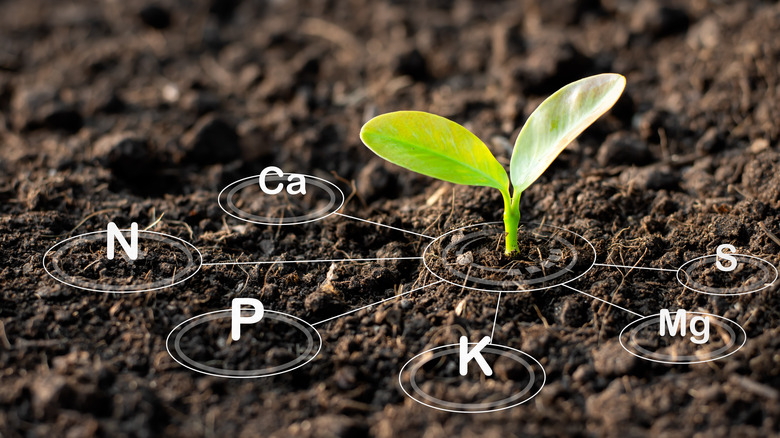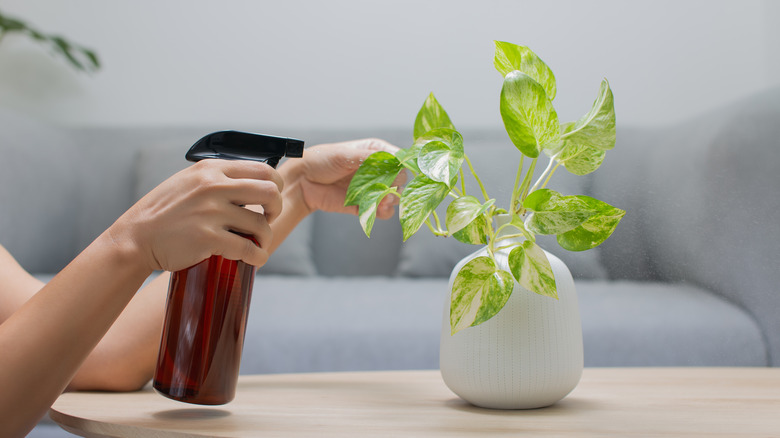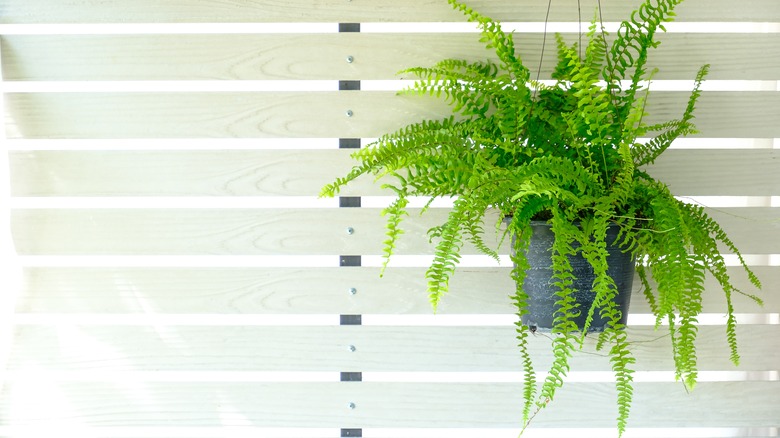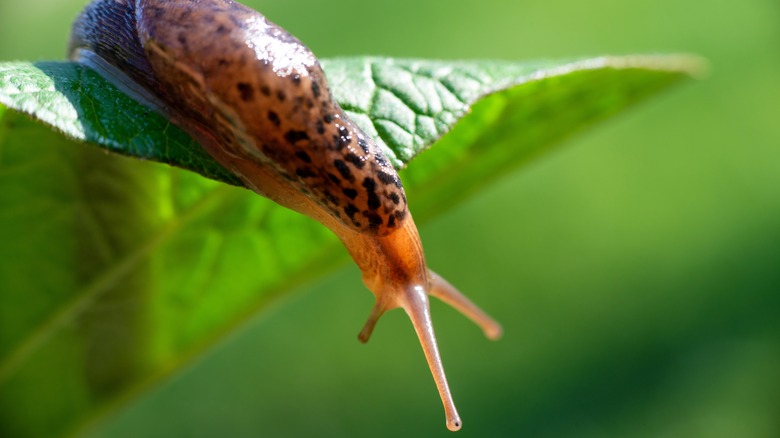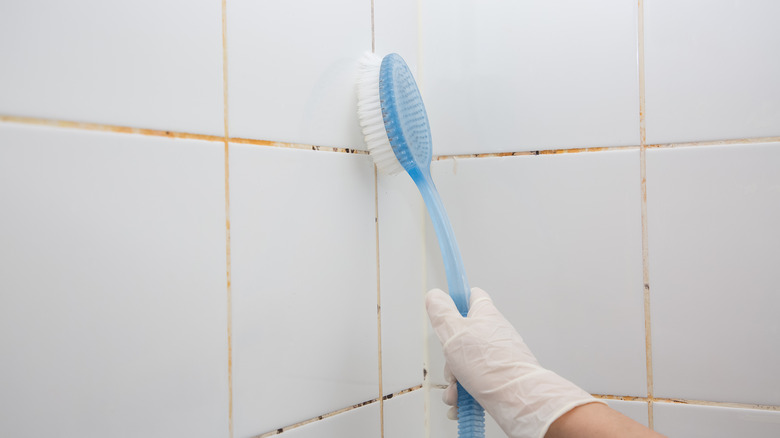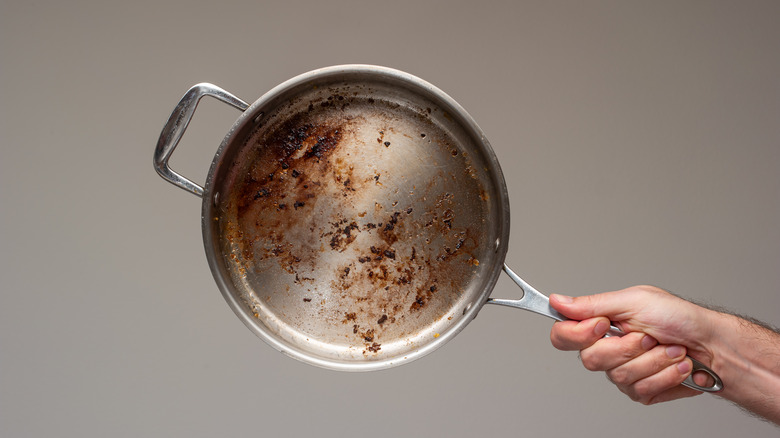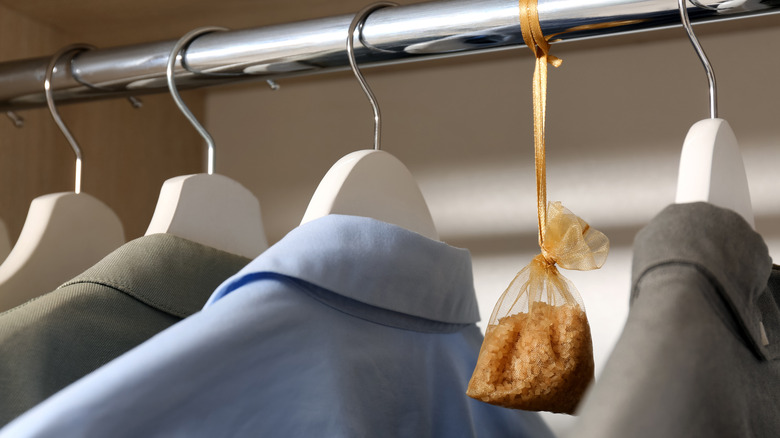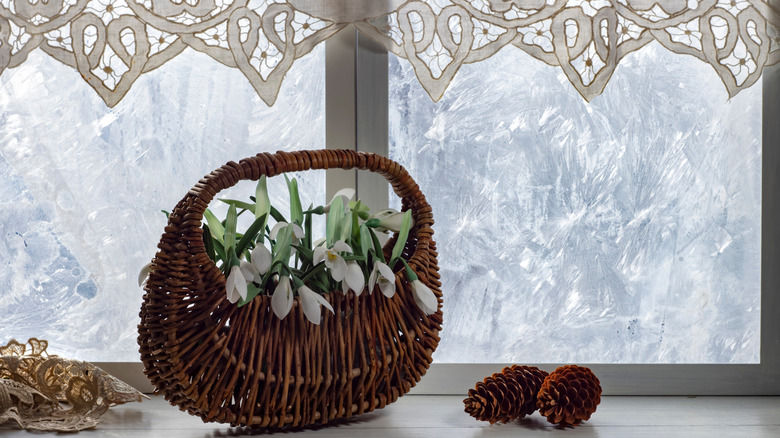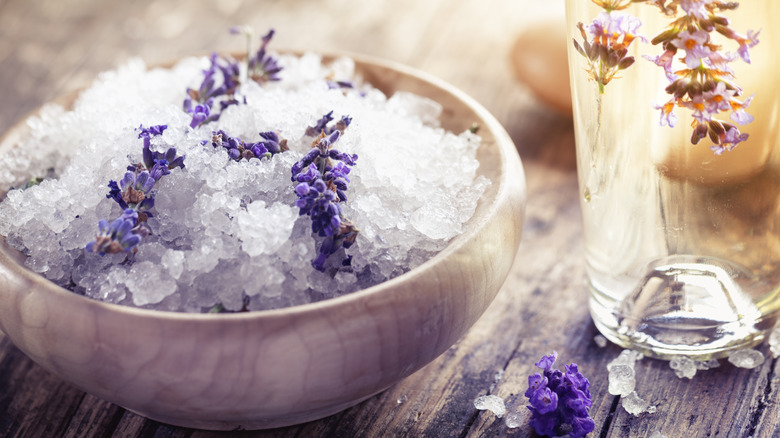Smart Ways To Use Epsom Salt Around The House
Do you like your cleaning products to be cheap, non-toxic, and versatile? Or maybe you're looking for a way to quickly pep up your house plants? Epsom salt is hard on dirt while being light on your wallet and the environment. You can use it to tackle stubborn grime, plant deficiencies, and even certain pest problems. First discovered in the 1600s, Epsom salt isn't actually a type of salt at all. Instead, it's a form of magnesium sulfate. It got its name from the town of Epsom and the crystalline structure it takes on. Containing 51% water, this handy household ingredient looks a lot like coarse salt, but it won't make your counters sticky or your metal utensils rust.
Its neutral pH also renders it gentle on the hands and easy to use as a DIY soil additive. Speaking of soil, Epsom salt is naturally found in the ground. Unlike chemical cleaners and detergents, it won't cause harm to local bodies of water if it's poured down the drain or used outdoors. If used in large quantities (like in agricultural settings and mining), magnesium sulfate can affect groundwater sources. However, wise home use is unlikely to have a negative impact, as it is a basic compound in soils and water. Ready to learn all the ways you can use Epsom salt to make your plants thrive and your home sparkle? Buckle up for some bright ideas.
Remediating magnesium-deficient soils
One of the most common household uses for Epsom salt is as a natural fertilizer. Epsom salt is a pure form of magnesium sulfate, which plants need for chlorophyll production, respiration, and other key functions. Magnesium can also help plants take up and metabolize other minerals, such as phosphate. However, the science world can't establish a consensus on whether Epsom salt as a fertilizer works or not. While it's scientifically established that it can help remedy magnesium deficiencies in plants, some studies show that it only slightly helps with yielding larger blooms or more bountiful crops. However, if you have a spare bag lying around your house and your outdoor plants look like they might need a boost, it's still worth a try. What doesn't work for some gardeners might work for others. If your soil could do with some magnesium, you can sprinkle Epsom salt directly on the surface by applying just under 1/2 a teaspoon per square foot. If you want to water with it, dissolve 2 tablespoons of Epsom salt in your watering can and apply once a month.
But before you bust out that box of Epsom salt and start sprinkling it around your plants, there are a few things to be aware of. Firstly, it is possible (and easy) to give plants too much magnesium. Excessively high levels of magnesium in the soil can cause multiple problems. It can trigger nutrient lockout, depriving plants of other essential elements like boron and manganese, and impact root microbial activity.
So how do you avoid this? The best way is to get your soil tested. You can do so by sending a sample to a nearby extension office, which you can look up here. If your plants are showing signs of what you think might be a magnesium deficiency, sending a sample for testing will reveal exactly what's going on in your ground. Magnesium deficiencies aren't all that common, but they can crop up in sandy or acidic soil, or ground that's been over-cultivated.
As a foliar spray
Another way you can use Epsom salt on your plants is via foliar feeding. To make a basic foliar feed, simply dissolve 1 tablespoon of Epsom salt per gallon of water. Spray this on affected plants twice per month.
If you're not familiar with the concept, foliar feeding is the practice of spraying essential nutrients onto plant leaves and stems to address deficiencies. The advantage of this approach is that you can help correct the plant's nutrient levels faster than by feeding the soil. In fact, this has been proven to work more efficiently than simply adding Epsom salt to the soil. That's because the salt is water-soluble. Thanks to this, it's a fast-release form of magnesium sulfate, which can have a downside in soil. Unlike slow-release sources of nutrients, such as compost, water-soluble forms can easily leach away after a heavy rain or a bout of overwatering. If you want to address magnesium deficiencies long-term, incorporating slow-release sources into your soil can be a better solution. But for a fast fix, Epsom salt in a foliar spray can yield snappy results without the worry of the magnesium washing away.
As we outlined above, the best way to determine whether your plants are hungry for magnesium is to get your soil tested. But if you've mainly got plants in containers and pots, with different growing mediums or soil mixes in each, this can be a bit tricky. Are you noticing yellow leaves with green veins? Or brown spots? Both of these issues can indicate a magnesium deficiency. If you see no change after an Epsom salt foliar feed, the yellowing leaves might stem from a different problem, such as low iron levels, a pH imbalance, or even a glut of available nutrients.
For greening up pale ferns and other pot plants
There's almost nothing sadder than a paling fern. Lots of things can cause leaves to turn pale green or yellow, but one of the top triggers is a lack of magnesium. Magnesium is a key element in chlorophyll, which is what makes plants green. If your fern has a magnesium deficiency, giving it a boost with Epsom salt can restore its glossy glory. To feed your ferns, simply dissolve 1 tablespoon into a gallon of water to treat them to a magnesium-rich drink once a month.
You can use this trick for other indoor plants as well. If the foliage is looking less than verdant, there's a good chance you're dealing with low nutrient levels. Potted plants are especially vulnerable to nutrient deficiencies because they have a limited amount of soil to feed on. Overwatering pot plants can literally wash out water-soluble nutrients like magnesium from the soil.
If your plants are looking woebegone and it's been a while since you up-potted them, you should probably think about giving them a larger container with fresh soil at some point. But in the meantime, a pinch of Epsom salt could be the perfect quick fix. Not sure if low magnesium levels are the cause behind your pale, lackluster houseplants? One thing to look for is where the yellowing is occurring. Plants that don't have enough magnesium often demonstrate yellowing in older leaves on the bottom, as they concentrate their stores in the fresh growing tips.
To ward off slugs
The bane of gardeners the world over, slugs can wreak havoc in your yard in just a night. Before you know it, your crisp, young lettuces are full of holes, seedlings have been demolished, flowers chomped, and the leaves on your cabbages look like a crochet project. Epsom salt isn't effective at eradicating slugs on an agricultural scale, but this doesn't mean you can't use it in your garden to help deter these pesky little critters. While there is no scientific evidence this works, there is plenty of anecdotal evidence found everywhere from gardening forums to newspapers to major gardening websites, so it's worth a try if you have some salts handy.
Simply sprinkle a small ring around your most vulnerable plants, such as lettuces, brassicas, peas, and beans. This ring will act as a kind of barricade that the slugs may hesitate to cross. Epsom salt is an abrasive substance, and the sharp crystals can't feel comfortable on the underbelly of a slug! Just be careful not to use too much, as you don't want to create an overabundance of magnesium sulfate in the soil.
If you've already been investigating ways to get rid of slugs, you might have heard that table salt around the base of plants can stop them and other mollusks from munching at them. While this may be true, applying table salt to your garden isn't a good idea for deterring slugs, as most plants don't like saline soils. Because Epsom salt isn't actually salt, you can safely use it in the garden without the risk of raising salinity levels.
For scrubbing grimy grout
Not only can Epsom salt help you combat cockroaches, but its abrasive structure can also prove handy for lifting dirt from grout lines. All you have to do is dip a damp scrubber into some soap, then into a bowl of Epsom salts, and work the crystals back and forth along the grout. Some guides recommend that you let the Epsom salt sit overnight in the grout lines, but this isn't likely to have much of an effect. Because of its neutral pH, Epsom salt doesn't have any chemical cleaning properties. On a chemistry level, it's not going to "eat" away at dirt the way a strong acid or alkaline substance can. Its cleaning power lies in its abrasive, scratchy crystals. These crystals are strong enough to scrape at particles of dirt in hard-to-reach places like grout.
Besides helping to scrub away stubborn grime, Epsom salt also has certain antibacterial actions, which is always a good thing in areas like the bathroom, kitchen, and hard-working floors. So far, there aren't many studies that cover this. However, a 2014 paper published in the Journal of Applied Sciences Research showed that Epsom salts successfully inhibited Staphylococcus bacteria derived from sewage samples.
As an abrasive substance for scouring out pots and pans
The abrasive structure of Epsom salt can also be helpful for cleaning pots. If you're tired of wasting precious energy and elbow grease on burned pans, here's how Epsom salt can help. Start by soaking the offending pot or pan with water. You can either leave it to soak overnight or speed things up by heating some water in it on the stove. To up the ante even further, add a dot of dishwashing liquid to the mix. After soaking, pour a couple of tablespoons of Epsom salt into the pot and start scrubbing. If you've got some stubbornly stuck food on your hands (or rather, your pot bottom), the Epsom salt crystals might dissolve before you're done scouring. If this happens, simply add some more.
Speaking of dissolving, there is one caveat about using Epsom salt as an abrasive cleaning agent: Once you dissolve it, the Epsom salt crystals will lose their scrubbing power. The salt itself doesn't act as a cleaning agent, but rather as a scrubber. It's also something to be aware of if you come across a recipe that directs you to dissolve Epsom salt in water or a soapy solution.
For creating scent bags to hang in your closet
There's practically nothing more pleasant than pulling out a crisp, clean piece of clothing from your closet, free from musty odors. If you want your garments and everything else in your cupboards to smell as fresh as daisies, then Epsom salt, rice, some essential oils, and a few small bags are all you need. In a bowl, mix a 2:1 ratio of rice and Epsom salt, and add your essential oil of choice. Lavender is a popular option for scent sachets, but you can create your own unique combination. Rose, lemon, grapefruit, jasmine, patchouli, sandalwood... The options are endless. Aim to use roughly 20 drops of essential oil per cup of Epsom salt and rice. For an extra-special touch, you can even add dried flower petals.
As far as what bags to use, here are some quick ideas. You can pick up a few drawstring cotton bags, re-use any spare organza jewelry pouches you have on hand, or even make your own bags. For a no-sew solution, simply cut out squares of muslin material and place your scent mix in the middle. Gather up the corners and tie them tightly with a strip of wide ribbon. If you leave some length on the ends, you can also use the ribbon to secure the scent bags to your wardrobe's hanging rails.
For adding shimmer to DIY holiday decor
If you want to inject some shimmer, shine, or faux ice crystals into homemade holiday decor items, Epsom salt could be the perfect addition to your arsenal of craft supplies. The Epsom Salt Council has a couple of creative examples on their site, including festive mason jar mugs. To add a crystalline sparkle, you'll need Epsom salt, mason jars, and craft glue. Apply the glue to your jars in the shape of holiday motifs. Stars or Christmas trees are two simple options. Before the glue dries, dip the jars into a bowl filled with Epsom salt. Feel free to extend this bright (pardon the pun) idea to baubles, candles, etc. If you have a dried-branched Christmas wreath or a real tree you want to jazz up, a little bit of glue and some Epsom salt in the right places can create a frosty look.
You can also use Epsom salt to create frosted window art. Begin by dissolving roughly 1/3 cup of Epsom salt in a 1/2 cup of hot water. If the crystals aren't dissolving, you can place the solution in the microwave to speed things up. Add a small squirt of dishwashing liquid, dip a cloth into the solution, and apply to a window pane. Crystal structures should start to appear as the liquid dries. When it's time to take down the tinsel and holiday decor, you can remove your window frosting with a damp sponge.
Making Epsom salt potpourri
If you like your home to smell good, why stop at your closet? You can use a similar technique to the scent sachets mentioned above to make Epsom salt potpourri. You won't need rice for this easy recipe; instead, simply combine Epsom salt, your favorite essential oils, and some dried flower petals. If you can't get dried flower petals, that's also fine. The essential oils will provide more than enough aroma. Epsom salt potpourri is very decorative, so don't be shy to display it in bowls, glass vases, or canisters around your home.
If you're not sure what essential oils to use, here's a fun idea. Instead of making just one "flavor" of potpourri, tailor the smell to each room. Thanks to its potential sleep-improving properties, lavender is a great choice for the bedroom. When it comes to your home office, you may want a more invigorating, energizing scent, such as citrus, vetiver, or lemon grass. You can also get creative by switching out essential oil aromas according to the seasons. Clove, cinnamon, orange, vanilla, and cedarwood are all quintessential fall favorites. Bright, zesty lemon, lavender, lime, and mint can make for invigorating springtime scent bouquets. Rich floral tones like jasmine might strike the perfect note in summer.
